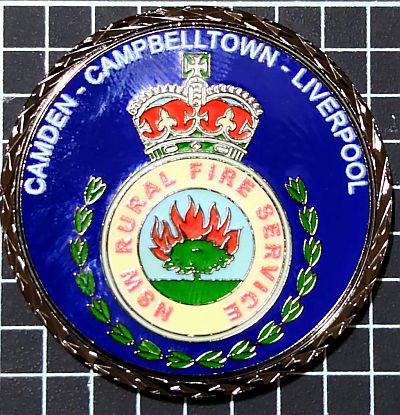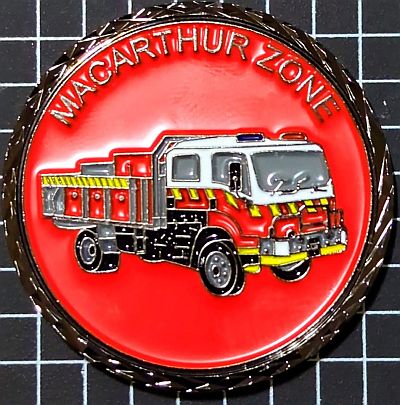A fire brigade challenge coin from New South Wales, Australia
Challenge Coins
Immediately after posting the Code 9 “Senses” Challenge coin, I was asked “What is a Challenge Coin?”
Challenge coins originated in the military, although how far back is hard to be certain.
Peter Morrell goes back to Roman times and how some of their coins featured insignias from local legions—the largest military unit of the Roman army.
Sometimes, when a legionnaire (Roman soldier) went above and beyond, the powers in charge would reward them with one of these coins. It was extra pay, but also a nice memento after a hard day of soldiering.
While Peter does not give a specific example, there are many Roman coins which feature “Aquila”, the battle standard of a legion. Perhaps the most famous Roman coin is the “Eid Mar“, the denarius commemorating the assassination of Julius Caesar. This coin was minted by Brutus during the Battle of Philippi as a means of paying his soldiers. Does that count as a Challenge Coin?
In a probably apocryphal story, challenge coins got their start during World War I, when an American pilot, who had been shot down over France and lost his dog tags, was able to prove his Allied affiliation to French soldiers on the lookout for German spies by showing them a bronze medal made by a wealthy Army Air Service lieutenant.

The first verifiable modern military coin was commissioned by then-Lt. General (and then Colonel) William “Buffalo Bill” Quinn and handed out to his soldiers. The 1950 and 1952 represent the years the 17th Infantry entered Korea and the year the coin was produced, respectively. 1812 was the year the 17th Infantry was activated.
Special operations teams were among the first military groups to run with the idea of a unit challenge coin.
It reportedly started in the 1960s when members of the 11th Special Forces Group (SFG) took regular monetary coins and stamped their insignia over the top of them.
The “Challenge” part of the name reportedly comes from a challenge, or coin check. This initiated when one person either places their coin on a table hard enough to be heard or pulls their coin out and verbally announces the challenge. Everyone present must also produce their coin. Anyone who can’t buys a round of drinks. If everyone can, the challenger has to buy a round.
The tradition of coin checking also began in Germany after World War I. American personnel who were stationed in Germany adopted the local ritual of “Pfennig” checks.
A Pfennig was the lowest denomination of German currency. If a service member did not have a Pfennig, they would have to buy the next round of drinks. This ritual carried over and became part of the challenge coin tradition.
Today, one of the most famous uses of Challenge Coins is when the President of the United States passes one of their coins in a handshake.
More commonly now, the idea of challenge coins has grown beyond the military, particularly to police and other services. Coins such as the Code 9 Senses Challenge Coin are often made for fundraising and to spread awareness and support of a cause. Units and groups often create the coins for themselves and to sell more widely to raise money for group projects or goals.
Obverse

The obverse of this coin features the New South Wales Rural Fire Service Insignia “the crest image is a green tree alight with a red fire against a blue sky, with an annulus circled by a full green wreath below an imperial red, white and green coloured crown. The words, in capitals, NSW RURAL FIRE SERVICE appear within concentric circles.”
Around the top are the areas CAMDEN, CAMPBELLTOWN, LIVERPOOL, which are all on the south-western edge of Sydney, the capital of New South Wales, Australia.
Reverse

The reverse features the words MACARTHUR ZONE above an image of a fire truck facing right. RFS designate “Categories” for appliances depending on size, type and function. This is possibly a Category 1 or “Cat 1” tanker. A tanker is a truck, generally off-road capable, which primarily carries a large amount of water. These can travel into the countryside and bring water with them to attack a fire. This is different from other vehicle types such as a “pumper”. Pumpers carry less water, but have a larger pump, which is useful in urban areas where access to water mains is readily available.
The NSW RFS comprises almost 2,000 rural fire brigades with a total volunteer membership of approximately 72,000. This is broken up into districts and zones. Macarthur Zone covers Camden, Campbelltown and Liverpool Fire Control Centres (FCC). Each of these covers 7-9 brigades. This coin was given to me by an RFS volunteer from this zone, so is quite special to me personally. Have you got a challenge coin which was given to you? I’d love to see it! Do let us know below or on social media.


Leave a Reply